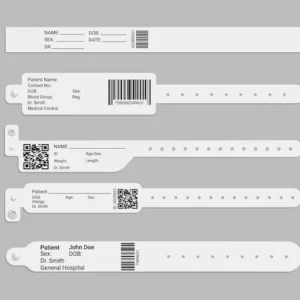Description
Indian Barcode Healthcare pioneered patient identification wristbands and continues its history of innovation and intelligent design with an expansive patient ID portfolio that no other company can match. From print-on-demand laser and thermal wristbands to color-coded alert wristbands and snaps, blood bands and more, we have every patient ID application covered for the entire patient population, from newborn to geriatric. We have wristbands that are compatible with Epic, Cerner, Med-tech, and all other leading EMR systems.
You can get the Best Price for Hospital wristbands from Mindware. For Wristbands Call 9717122688 and Mail ID gm@indianbarcode.com
visit our website :https://www.myndsglobal.in/
get our best price on product on this website https://www.semiconductorsindia.com/products/hospital-wrist-bands
Features of RFID Hospital Wristbands:
- Identification:
- The wristband contains an RFID tag that holds a unique identification number or patient data, such as name, medical record number, allergies, and other critical information. The RFID chip can be scanned remotely by healthcare staff, providing quick access to the patient’s medical records.
- Real-time Tracking:
- RFID wristbands enable real-time tracking of patients within the hospital, making it easier to monitor their movement, check-in and check-out times, and even monitor their condition in certain cases.
- Improved Patient Safety:
- RFID technology reduces the risk of misidentification or medical errors, as it ensures that the right treatment, medication, and procedures are administered to the right patient by scanning the wristband before any medical action is taken.
- Easy Integration with Hospital Systems:
- RFID wristbands are integrated into the hospital’s electronic health record (EHR) systems, allowing for seamless updates and access to medical records, lab results, and medication prescriptions in real time.
- Barcode and Barcode Scanning Support:
- Some RFID wristbands may also include a barcode for dual-mode scanning, providing flexibility if RFID readers are unavailable or for use in specific scenarios.
- Durability and Comfort:
- The wristbands are typically made from lightweight, durable materials that are comfortable for patients to wear for extended periods. Some are waterproof or water-resistant to ensure functionality even during bathing or other activities.
- Access Control:
- RFID can also be used for access control, such as allowing authorized personnel to enter secure areas of the hospital or monitor restricted zones within the facility.
Benefits of RFID Hospital Wristbands:
- Enhanced Patient Safety: RFID reduces the likelihood of medical errors such as mismatched treatments, medications, or surgeries.
- Efficiency in Hospital Operations: RFID wristbands streamline hospital workflows, including patient registration, medication administration, and surgical procedures.
- Prevention of Patient Mix-Ups: By using RFID wristbands, hospitals can ensure the right patient is receiving the right care.
- Improved Inventory and Asset Management: RFID can also be used to track medical equipment and medications, reducing the chances of misplaced items and improving overall hospital management.
- Reduced Wait Times: With the automation of patient data collection and access, hospitals can process patients more quickly, reducing delays and wait times.
Applications of RFID Hospital Wristbands:
- Patient Identification and Registration: Upon admission, patients are given an RFID wristband containing their unique ID, which links to their medical records, ensuring accurate identification.
- Medication Administration: Nurses and healthcare professionals can use RFID readers to verify patient identities before administering medication or treatments, reducing errors.
- Surgical Procedures: RFID wristbands are scanned before surgery to confirm the patient’s identity, surgical site, and procedure, helping to prevent wrong-site surgeries.
- Location Tracking: RFID wristbands allow the hospital to track the patient’s location, which can be vital in case of emergencies or for monitoring patients with specific needs (e.g., those prone to wandering).
- Infant Protection: In maternity wards, RFID wristbands can be used to prevent baby-switching by linking the infant’s wristband with that of the mother.
Challenges:
- Cost: The initial setup for RFID systems in hospitals can be expensive, including hardware (RFID tags and readers) and software integration.
- Privacy and Security: Ensuring patient data privacy and securing RFID systems against hacking or misuse are important considerations when using these devices.
- Battery Life: Some RFID wristbands are powered by batteries, so ensuring their longevity is crucial, particularly for long-term hospital stays.
Conclusion:
RFID hospital wristbands enhance the safety and efficiency of healthcare environments by offering real-time patient identification, reducing errors, improving operational workflows, and ensuring seamless data integration with hospital management systems. Their growing use in modern hospitals shows significant improvements in patient care and hospital administration.






Reviews
There are no reviews yet.